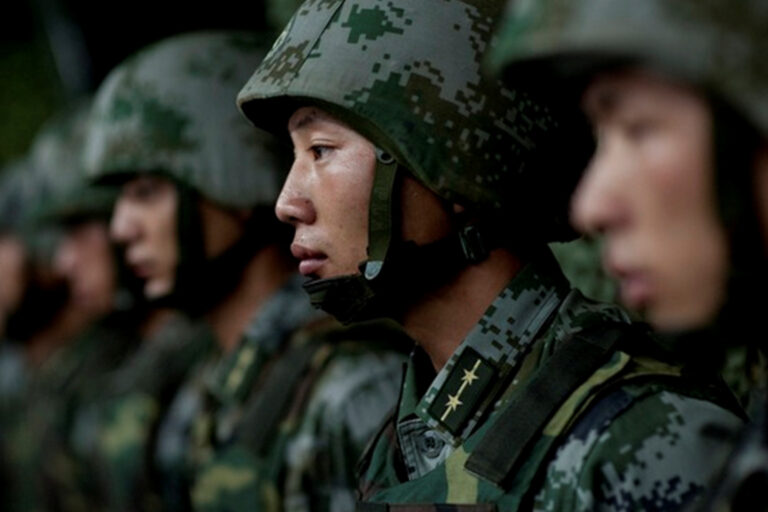Dr. Simi Mehta holds a Ph.D. in US Studies from the School of International Studies, Jawaharlal Nehru University, New Delhi and a Fulbright Fellow at Ohio State University. She is the CEO and Editorial Director of The Impact and Policy Research Institute (IMPRI), New Delhi. She can be reached at [email protected].
On January 25, 2018, in celebration of 25 years of constructive engagement, the ASEAN-India Commemorative Summit was held in New Delhi. The leaders of India and all ten ASEAN countries attended the Summit, themed “Shared Values, Common Destiny.” Known for its political and diplomatic maneuvering, the Narendra Modi government wasted no opportunity to create history by presenting a formidable soft power force against China’s assertiveness in the South China Sea and the Indo-Pacific. With the US National Security Strategy 2018 clearly embracing “Indo-Pacific” discourse,[1] as well as the renaming of the US Pacific Command to Indo-Pacific Command,[2] the United States is clearly renewing its emphasis on economic, security, and maritime stability in the Indo-Pacific region.[3] Amid this, India and Southeast Asian nations have intensified their calls for greater engagement with each other as well as with like-minded countries such as Japan, Australia, and the United States.
I assess the evolving Indo-ASEAN relationship based on India’s Act East policy. The Act East policy is indicative of India’s holistic efforts to counter China’s large-scale regional investment and influence through social, cultural, economic, and geopolitical engagement with ASEAN. I argue that the present form of India-ASEAN engagement is beneficial for ASEAN because of its joint foundations in geopolitical, economic, and socio-cultural affairs, and furthermore because of its potential to counterbalance China’s regional territorial aspirations.
India’s efforts to more intimately engage ASEAN countries have produced mixed reactions of support and skepticism from the ASEAN countries. Despite this, the threats posed by China’s expansionist tendencies have been recognized on both sides, suggesting that Robert Kaplan’s 2011 warning of China’s territorial ambitions has come true.[4] It is in the best interests of both India and ASEAN to stay focused on freedom of navigation and openness of the seas, along with the socio-cultural, economic, and geopolitical benefits that would accrue through deepened India-ASEAN cooperation.
ASEAN: A Regional Grouping that India Cannot Ignore
ASEAN’s centrality to India’s foreign policy is illustrated by the range of India’s investments and high-level engagements over the past several years, starting with the 2014 launch of the Act East policy. Then, in November 2015, India allocated US $1 billion for comprehensive physical, digital, civilizational, and people-to-people connectivity with ASEAN.[5] In July 2017, as part of the 25th anniversary celebrations of ASEAN-India relations, then-Foreign Secretary of India Subrahmanyam Jaishankar delivered a speech emphasizing the close alignment between India and ASEAN, which symbolized India’s efforts to garner ASEAN support in India’s quest for prosperity, stability, and security.[6] Following this, Prime Minister Modi penned an editorial in January 2017 that outlined a vision of shared values and common destiny between India and ASEAN, as the two have transcended from dialogue partners to vital strategic partners.[7] The editorial appeared in 27 newspapers and ten languages across the ASEAN countries.[8]
These developments contextualize the three fronts of India-ASEAN engagement: geopolitical, economic, and socio-cultural.
a) Geopolitics
India’s Southeast Asia policy focuses on maintaining an equitable strategic balance, strengthening partnerships, and preventing regional rivalries from destabilizing the region. In response to expansionist Chinese overtures, from its “string of pearls strategy,”[9] “One Belt One Road,”[10] and increasing naval presence in the South China Sea and the Indian Ocean,[11] New Delhi has decided to initiate strategic dialogues and military exercises with ASEAN states.
ASEAN countries’ concerns about China are evident from their jubilant responses to the Permanent Court of Arbitration’s (PCA’s) July 2016 verdict invalidating Chinese claims of “historic rights” to control over islands in the South China Sea. The Philippines, in particular, has clashed with China over the latter’s effective control of the disputed Scarborough Shoal.[12] After China refused to accept the PCA’s judgment, India became a prominent advocate for a “rules-based international order.” Prime Minister Modi described “ASEAN-India cooperation in the maritime domain” as “one of the key focus areas for growth and development for the Indo-Pacific region.”[13] He affirmed that humanitarian and disaster relief efforts, security cooperation, and freedom of navigation would be key focus areas for maritime cooperation with ASEAN.
Scholars such as Kanti Bajpai and Thitinan Pongsudhirak have observed that ASEAN countries seem to expect India to strategically balance China.[14][15] Indeed, the joint “Delhi Declaration”[16] issued during the Commemorative Summit reaffirmed the need for counter-terrorism efforts, a rules-based maritime order, and freedom of navigation – areas in which India is expected to take the lead.[17]
b) Economics
Taking advantage of shared geopolitical insecurities, India has consistently pushed for greater economic integration with ASEAN and has sought to present itself as an attractive investment destination. Its efforts to enhance trade and investment cooperation have emphasized geographical contiguity and lifestyle similarities.
Trade, in particular, has been a vital mutual interest between India and ASEAN. Bilateral trade between India and ASEAN grew from a meager $7.06 billion in 2000-01 to a massive $78.9 billion in 2011-12. Despite a noteworthy decline to $65 billion in 2015-16, it witnessed renewed growth to $71.6 billion in 2016-17.[18]
During the ASEAN-India Commemorative Summit, Modi offered to establish manufacturing hubs in Cambodia, Laos, Myanmar, and Vietnam offering a $1 billion credit line to promote sea, air, and road connectivity projects with ASEAN. Jaishankar described connectivity as the “new Great Game” and noted that physical connectivity projects were the key to communicate India’s “seriousness” about its Look East policy.[19]
With the signing of the ASEAN-India Agreement on Services and Investments, ASEAN and India are likely to benefit from an extended market, where air connectivity aims to play a pivotal role in tapping into new and emerging markets, especially for facilitating commerce, investment, and tourism.[20] The creation of an ASEAN-India Air Transport Agreement,[21] as well as direct flights connecting Tier II and Tier III cities in India,[22] promise to enhance the potential for greater connectivity.
c) Socio-cultural
India has emphasized the importance of cultural and religious similarities to deepen ties with ASEAN countries. For instance, India is hailing its diaspora, as well as ASEAN citizens of Indian descent, as cultural ambassadors. As Modi wrote in his editorial “Indians have always looked East to see the nurturing sunrise and the light of opportunities”.[23]
Southeast Asia remains an attractive destination for Indian tourists, given its historical sites and affordability. In 2015, over 3.3 million Indians visited ASEAN countries. Conversely, India’s tourism industry under-performs, leading to modest flows of Southeast Asians to India, but it has grown as Indian facilities have improved.[24]
To mark the contributions of overseas Indian communities to India’s development, every year the Pravasi Bharatiya Diwas (PBD), or “Day of Overseas’ Indians,” is celebrated both in India and globally among the Indian diaspora.[25] In 2018, India organized the PBD in Singapore specifically to celebrate the ASEAN-Indian partnership, with the theme “Ancient Route, New Journey: Diaspora in the Dynamic ASEAN India Partnership.”[26]
Even more visibly, 2019 was declared the year of India-ASEAN tourism. India has offered to host an ASEAN-India Start-up Festival and has also offered 1,000 Indian Institute of Technology (IIT) scholarships for doctoral students from ASEAN countries.[27] At the ASEAN-India Commemorative Summit, New Delhi also announced a dedicated training course on highway engineering and promised to set up a virtual network of universities and pilot projects to establish digital infrastructure.[28] Additionally, India has planned to award the Padma Shri (one of India’s top civilian awards) to one eminent citizen from each ASEAN country.
Exaggerated Celebration of India-ASEAN Ties?
While the symbolism of inviting ASEAN leaders as Chief Guests to India’s Republic Day parade cannot be understated, the strategic convergence appears to be largely driven by concerns about China. In particular, given the uncertain role of the United States in the region, ASEAN likely expect India to play a more active role in counterbalancing China.[29]
ASEAN’s exhortation for India to “stand with ASEAN” and conclude the Regional Comprehensive Economic Partnership by 2018 did not achieve concrete commitments. Frederic Grare argues convincingly that India’s protectionist instincts have negatively impacted its regional profile and highlighted its weaknesses, leading to frustration among other member nations by slowing down or impeding the negotiations.[30][31] The status quo on trade could jeopardize India’s regional standing given the strong Chinese economic presence in ASEAN nations, especially on the mainland.
Some Indian offers of assistance to ASEAN,[32] like access to its indigenous GPS-aided Geo Augmented Navigation (GAGAN) system,[33] received no interest from ASEAN. Some ASEAN members, such as Thailand, instead chose an alternative technology from China.[34] Further, the concept of a maritime transport agreement has been in the works for several years, because inter-ministerial tensions within the Indian government have prevented the project from achieving its targets.[35] Meanwhile, the China-ASEAN Investment Cooperation Fund (CAF) plans to raise $3 billion for a new dollar fund for investments under the Belt and Road Initiative in Southeast Asia.[36]
In 2018, China’s state-run Global Times described New Delhi as a “beginner” in geopolitics that was using a “bluff” to exaggerate its importance in the region.[37] It downplayed the India-ASEAN trade relationship, highlighting ASEAN’s trade volume with China—six times that with India—and China’s investment in the region—10 times that of India. Drawing parallels with the United States, the editorial sneered at India’s comparison of itself to China, which has a GDP five times that of India, arguing that “China never compares itself to the US, because its GDP is only two-thirds that of the US.”[38]
Even though China dismissed the India-ASEAN Commemorative Summit and portrayed India as lowly in regional geopolitics, the fact that a leading state-run newspaper wrote the op-ed to negate the event point by point demonstrates the Chinese government’s deep discomfort with India’s outreach to ASEAN.
Concluding Observations
To achieve its goal of deepened integration with ASEAN, India has established and continuously emphasized opportunities for economic and security partnership. All the while, it has simultaneously appealed to socio-cultural ties. Closer integration with ASEAN, India hopes, will allow the two to jointly balance China’s growing regional influence.
Conversely, a benign and non-hegemonic Indian economy (as compared to China) is too large for ASEAN to ignore. India’s rise does not threaten ASEAN in any capacity.[39] Rather, it affords ASEAN a means to counter expanding Chinese influence in the region.
India and ASEAN have each signaled recognition of the other’s indispensability in the region’s security architecture. This year’s Silver Jubilee of India-ASEAN Relations represented the achievements of years of diplomacy, most particularly surrounding Prime Minister Modi’s Act East policy. However, the real test for India and ASEAN will be whether the two sides are able to sustain their camaraderie and commitment to regional peace and stability amid China’s efforts to create a Sinocentric regional order.
Footnotes
[1] United States Department of Defense, “Summary of the National Defense Strategy, 2018- Sharpening the American Military’s Competitive Edge”, January 19, 2018, accessed September 1, 2018, https://dod.defense.gov/Portals/1/Documents/pubs/2018-National-Defense-Strategy-Summary.pdf.
[2] George, V.K., “U.S. Pacific Command renamed U.S. Indo-Pacific Command”, The Hindu, May 31, 2018, accessed September 1, 2018, https://www.thehindu.com/news/international/us-pacific-command-renamed-us-indo-pacific-command/article24043314.ece.
[3] The “Indo-Pacific” region is still poorly defined but is generally taken to extend from the east coast of Africa, across the Indian Ocean, and through the Western Pacific, including countries like Japan and Australia, to the west coast of the United States. Singh, A., “What does the term “Indo-Pacific” signifies [sic], as distinct from Asia-Pacific?”, Institute for Defense Studies and Analysis, 2018, accessed September 22, https://idsa.in/askanexpert/termIndoPacificsignifies.
[4] Kaplan, Robert D., “The South China Sea Is the Future of Conflict”, Foreign Policy, August 15, 2011, accessed September 14, 2018, https://foreignpolicy.com/2011/08/15/the-south-china-sea-is-the-future-of-conflict/.
[5] Ministry of External Affairs, Government of India, Annual Report 2015-16, Policy Planning and Research Division, Ministry of External Affairs, New Delhi, accessed September 25, 2018, https://www.mea.gov.in/Uploads/PublicationDocs/26525_26525_External_Affairs_English_AR_2015-16_Final_compressed.pdf.
[6] Ministry of External Affairs, Government of India, Speech by Dr. S. Jaishankar, Foreign Secretary to mark 25 years of India-Singapore Partnership at Shangri La Hotel, Singapore, July 11, 2017, accessed August 25, 2018, https://www.mea.gov.in/Speeches-Statements.htm?dtl/28609/Speech+by+Dr+S+JaishankarForeign+Secretary+to+mark+25+years+of+IndiaSingapore+Partnership+at+Shangri+La+Hotel+Singapore+July+11+2017.
[7] Modi, Narendra, “Asean-India ties: 25th anniversary – Shared values, common destiny”, The Straits Times, January 26, 2018, accessed September 1, 2018, https://www.straitstimes.com/opinion/shared-values-common-destiny.
[8] Ministry of External Affairs, Government of India, List of Newspapers from AEAN countries with Op-Ed by Prime Minister Shri Narendra Modi, accessed September 2, 2018, http://mea.gov.in/Images/amb1/List_of_Newspapers_with_Op_Ed.pdf.
[9] Hellenic Shipping News, Dhaka cancels port to be built by China, India eyes another, February 2, 2016, accessed September 24, 2018, https://www.hellenicshippingnews.com/dhaka-cancels-port-to-be-built-by-china-india-eyes-another/.
[10] The Henry M. Jackson School of International Studies University of Washington, “Balancing Cooperation and Competition: A New in Era in U.S.-China Relations”, Task Force Report 2016, accessed March 21, 2018, https://digital.lib.washington.edu/researchworks/bitstream/handle/1773/36217/TaskForceAReport-2016-Bachman.pdf?sequence=1.
[11] Ibid.
[12] Mehta, Simi, “China, a Scofflaw?”, Journal of Diplomacy, Seton Hall University, New Jersey, July 13, 2016, accessed January 30, 2018, http://blogs.shu.edu/diplomacy/2016/07/china-a-scofflaw/.
[13] Modi, Narendra, “Text of Opening remarks by the Prime Minister at the Plenary Session of the INDIA- ASEAN Commemorative Summit”, 25 January 2018, Press Information Bureau, Government of India
Prime Minister’s Office, accessed February 1, 2018, http://pib.nic.in/newsite/PrintRelease.aspx?relid=175909.
[14] Kanti Bajpai is Director, Centre on Asia and Globalisation and Wilmar Professor of Asian Studies at the Lee Kuan Yew School of Public Policy (LKYSPP), National University of Singapore, Singapore. See Bajpai, Kanti, “India’s ASEAN embrace: Unlike China, Southeast Asian countries do not have a problem with India’s rise”, The Times of India, January 27, 2018, accessed January 29, 2018, https://blogs.timesofindia.indiatimes.com/toi-edit-page/indias-asean-embrace-unlike-china-southeast-asian-countries-do-not-have-a-problem-with-indias-rise/.
[15] Thitinan Pongsudhirak is professor and director of the Institute of Security and International Studies at Bangkok’s Chulalongkorn University. See Kazmin, A. and J. Reed, “India courts SE Asian nations to counter the rise of China”, Financial Times, January 25, 2018, accessed January 29, 2018, https://www.ft.com/content/a95e2240-00d3-11e8-9650-9c0ad2d7c5b5.
[16] Ministry of External Affairs, Government of India, “Delhi Declaration of the ASEAN-India Commemorative Summit to mark the 25th Anniversary of ASEAN-India Dialogue Relations”, January 25, 2018, accessed January 29, 2018, https://mea.gov.in/bilateral-documents.htm?dtl/29386/Delhi+Declaration+of+the+ASEANIndia+Commemorative+Summit+to+mark+the+25th+Anniversary+of+ASEANIndia+Dialogue+Relations.
[17] The issue of terrorism gained considerable traction both by India and ASEAN members. President of the Philippines, Rodrigo Duterte, focused on methods to counter urban terrorism. The Delhi Declaration affirmed that there “can be no justification for acts of terror on any grounds whatsoever”. India and ASEAN have increased joint efforts for combatting terrorism through close cooperation by disrupting and countering terrorists, terrorist groups and networks, including cross-border movement of terrorists and foreign terrorist fighters and misuse of the internet, including social media, by terror entities.
[18] The decline during 2015-16 was attributed to the harmful effect of fall in crude prices; appreciation of rupee against dollar vis-à-vis other currencies like the euro, Brazilian real, Russian rouble, or Chinese yuan; and slower growth in world trade. Singh, R.K., “What’s Behind India’s Big Export Decline?”, The Diplomat, November 6, 2015, accessed March 21, 2018, https://thediplomat.com/2015/11/whats-behind-indias-big-export-decline/.
[20] Press Information Bureau, “India formally signs Trade in Services & Trade in Investments Agreement with ASEAN”, September 9, 2014, Ministry of Commerce & Industry, Government of India, accessed September 25, 2018, http://pib.nic.in/newsite/PrintRelease.aspx?relid=109489.
[21] Press Information Bureau, “Delhi Declaration of the ASEAN-India Commemorative Summit to mark the 25th Anniversary of ASEAN-India Dialogue Relations”, January 25, 2018, Prime Minister’s Office, Government of India, accessed September 25, 2018, http://pib.nic.in/newsite/PrintRelease.aspx?relid=175908.
[22] De, Prabir, “ASEAN-India Air Connectivity Report, Presentation at the Round Table on ASEAN-India Air Connectivity”, September 28, 2015, New Delhi, Research and Information System for (RIS) Developing Countries, New Delhi, accessed September 25, 2018, http://ris.org.in/sites/default/files/ASEAN-India%20Air%20Connectivity%20Report-PPT%2028%20Sep%202015.pdf.
[24] Yong, C., “Foreign ministers call for ASEAN and India to press on with economic integration”, The Straits Times, January 7, 2018, accessed September 1, 2018, https://www.straitstimes.com/singapore/foreign-ministers-call-for-asean-and-india-to-press-on-with-economic-integration.
[25] Pravsai Bharatiya Diwas, accessed February 21, 2018, http://www.pbd-india.com/.
[26] Shah, P.T., “The Pravasi Bharatiya kutumbakam in ASEAN”, The Hindu, January 22, 2018, accessed September 26, 2018, https://www.thehindu.com/news/international/the-pravasi-bharatiya-kutumbakam-in-asean/article22490218.ece.
[27] Indian Institutes of Technology (IITs) are India’s premier institutes of higher studies in technology.
[28] Digital infrastructure would involve setting up digital villages under the under the $1 billion line of credit that was offered to ASEAN, digital highway expansion from parts of India to Southeast Asia, digital economy for promoting cashless transactions and financial inclusion.
[29] Mitra, D., “Twenty-Five Years On, India, ASEAN Want to Be in Sync, but Keep Missing Cues”, The Wire, January 25, 2018, accessed March 21, 2018, https://thewire.in/diplomacy/twenty-five-years-india-asean-want-sync-keep-missing-cues.
[30] Frederic Grare is a non-resident senior fellow in the South Asia Program at the Carnegie Endowment for International Peace.
[31] Mitra, “Twenty-Five Years On, India, ASEAN Want to Be in Sync, but Keep Missing Cues”.
[32] Laskar, R. H., “Prime Minister Modi proposes $1bn line of credit for connectivity with ASEAN, Hindustan Times”, November 21, 2015, accessed September 15, 2018, https://www.hindustantimes.com/india/pm-modi-proposes-1bn-line-of-credit-for-connectivity-with-asean/story-VqSRhihw2jtpO5Th9XeTLI.html.
[33] Modi, Narendra, “Opening statement by Prime Minister at 13th ASEAN-India Summit in Kuala Lumpur”, November 21, 2015, Ministry of External Affairs, Government of India, accessed September 3, 2018, https://www.mea.gov.in/Speeches-Statements.htm?dtl/26050/Opening_statement_by_Prime_Minister_at_13th_ASEANIndia_Summit_in_Kuala_Lumpur_November_21_2015.
[34] Xinhua, “Beidou Navigation Satellite System set to serve ASEAN”, April 1, 2017, accessed September 24, 2018, http://silkroad.news.cn/english/2017/0401/61394.shtml.
[35] Mitra, “Twenty-Five Years On, India, ASEAN Want to Be in Sync, but Keep Missing Cues”.
[36] Julie Zhu, “ASEAN-focused China fundraising up to $3 billion for Silk Road projects: sources,” Reuters, January 23, 2018, accessed September 17, 2018, https://in.reuters.com/article/us-china-private-equity/asean-focused-china-fund-raising-up-to-3-billion-for-silk-road-projects-sources-idINKBN1FC0SE.
[37] Global Times, “India’s geopolitical bluff baffles China”, January 25, 2018, accessed January 29, 2018, http://www.globaltimes.cn/content/1086643.shtml.
[38] Ibid.
[39] There has been no instance of a feeling of threat in ASEAN amid India’s rise, nor does ASEAN harm India. See Kanti Bajpai and Swaran Singh, cited above, who explore the issue while assessing how the two sides have begun to look at each other to balance the rise of Chinese influence in the region.



